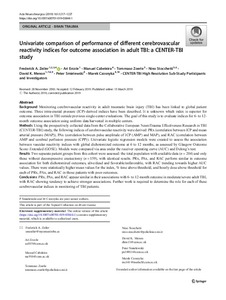Univariate comparison of performance of different cerebrovascular reactivity indices for outcome association in adult TBI: a CENTER-TBI study
Peter Smielewski; Marek Czosnyka; Manuel Cabeleira; CENTER-TBI High Resolution Sub-Study Participants and Investigators; Tommaso Zoerle; David K. Menon; Nino Stocchetti; Ari Ercole; Frederick A. Zeiler
https://urn.fi/URN:NBN:fi-fe2021042827103
Tiivistelmä
Background
Monitoring cerebrovascular reactivity in adult traumatic brain injury (TBI) has been linked to global patient outcome. Three intra-cranial pressure (ICP)-derived indices have been described. It is unknown which index is superior for outcome association in TBI outside previous single-center evaluations. The goal of this study is to evaluate indices for 6- to 12-month outcome association using uniform data harvested in multiple centers.
Methods
Using the prospectively collected data from the Collaborative European NeuroTrauma Effectiveness Research in TBI (CENTER-TBI) study, the following indices of cerebrovascular reactivity were derived: PRx (correlation between ICP and mean arterial pressure (MAP)), PAx (correlation between pulse amplitude of ICP (AMP) and MAP), and RAC (correlation between AMP and cerebral perfusion pressure (CPP)). Univariate logistic regression models were created to assess the association between vascular reactivity indices with global dichotomized outcome at 6 to 12 months, as assessed by Glasgow Outcome Score–Extended (GOSE). Models were compared via area under the receiver operating curve (AUC) and Delong’s test.
Results
Two separate patient groups from this cohort were assessed: the total population with available data (n = 204) and only those without decompressive craniectomy (n = 159), with identical results. PRx, PAx, and RAC perform similar in outcome association for both dichotomized outcomes, alive/dead and favorable/unfavorable, with RAC trending towards higher AUC values. There were statistically higher mean values for the index, % time above threshold, and hourly dose above threshold for each of PRx, PAx, and RAC in those patients with poor outcomes.
Conclusions
PRx, PAx, and RAC appear similar in their associations with 6- to 12-month outcome in moderate/severe adult TBI, with RAC showing tendency to achieve stronger associations. Further work is required to determine the role for each of these cerebrovascular indices in monitoring of TBI patients.
Kokoelmat
- Rinnakkaistallenteet [19207]
